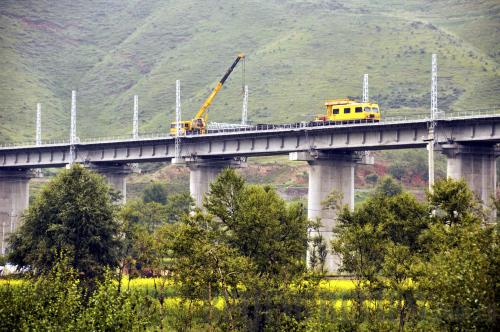|
 |
|
EARLIER THAN EXPECTED: A rail link in Qinghai Province connecting Xining, the provincial capital, and Gomud City will be completed by the end of 2010, 21 months ahead of schedule. The segment is part of the Qinghai-Tibet railway and will be able to transport 50 million tons of goods annually (NI SHUBIN) |
Numbers of the Week
534 billion
China's centrally administered state-owned enterprises reported combined profits of 543 billion yuan ($80 billion) in the first six months of this year, up 61.6 percent from one year ago, said the State-owned Assets Supervision and Administration Commission of the State Council.
25.2 million
China's third-generation (3G) mobile phone service subscribers reached 25.2 million at the end of June, said the Ministry of Industry and Information Technology.
TO THE POINT: Strong economic data from the first half of 2010 suggest China is leading the world out of the economic downturn. Lending to SMEs grew vigorously as banks regain confidence. Along with rising inflation, as spotted in the first half, comes escalating wheat prices, whose futures jumped 30 percent after weather conditions put a dent in overall output. China's online businesses continue to boom as an increasing number of consumers take to the Web. On the trade front, China and India have become the top exporters to the United Arab Emirates as Western companies cut their presence in the Gulf region.
By HU YUE
No Double Downturn
A "double dip" is unlikely for the Chinese economy in the second half of 2010, although the country's industrial value-added output and trade growth is expected to slow, said China's top industrial and commercial regulators.
China's industrial value-added output growth fell to 13.7 percent in June from 16.5 percent in May, raising concerns of recovery deceleration. But a year-on-year slowdown is inevitable as growths will be measured against last year's escalating growths month by month.
"We don't think there will be a 'double-dip' problem in the second half," said Zhu Hongren, spokesman of the Ministry of Industry and Information Technology. "China's industrial output may still grow more than 11 percent this year."
The slowdown is moderate and good for industrial restructuring because it is a result of active government controls, and China will continue to stabilize economic policies and help the recovery take hold for the remainder of the year, he said.
On July 20, the Ministry of Commerce forecasted declining exports prospects due to belt-tightening measures by EU governments deep in debt, and monetary tightening in Brazil, India and other emerging markets, in addition to material and labor cost increases and growing trade frictions.
While sovereign debt woes are cutting demand in the EU, China's biggest market, material and labor costs in coastal regions have increased 20-30 percent in the first six months, said Yao Jian, spokesman of the Ministry of Commerce.
As a solution, the ministry would retain tax rebates and offer easy credit to exporters, while importing more equipment and machinery for the processing industry, technology-intensive products and raw materials to facilitate the country's high growth, he said.
Export growth in the second half of this year may slow to just 16.3 percent, giving full-year growth of about 24.5 percent, the State Information Center, a leading government think tank, estimated.
Grain Price Hikes
Wheat purchasing prices have hit new highs since mid-June in China, but the country has enough grain reserves to guarantee domestic supply, said the State Administration of Grain.
China's summer grain output declined year on year for the first time after six straight years of growth. Even so, it's the third best harvest in the country's history. But prices of wheat futures have soared by up to 30 percent and at the spot market wheat prices exceeded the minimum purchasing prices the government set for the first time.
State-owned China Grain Reserves Corp. was held responsible for the price hikes, as it controls the bulk of grain reserves and can easily stabilize market prices for wheat, said the top grain regulator in a recent report submitted to the State Council.
Massive capital flows have pushed up the prices, too, said the report. More state-controlled enterprises, such as food manufacturer COFCO Ltd., compete in the grain market, and foreign companies such as Yihai Kerry of Singapore and Louis Dreyfus of France have joined the scramble for wheat in Shandong and Hebei provinces making competition fiercer.
Rising production costs, dramatic weather conditions and the government's stern measures to squeeze bubbles out of property and stock markets all account for the increases, said Yang Jianwen, a professor of economics at the Shanghai Academy of Social Sciences.
| 